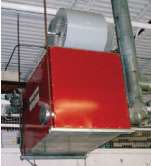Lube management deserves attention
Pure lubes aid in long trouble-free vehicle life
By John Baxter
For the cost-conscious operator of 10 or more trucks, bulk lubricant storage – or at least storage of 55-gallon drums – is the rule, which means heeding several important details regarding storage and disposal.
The choice between bulk and packaged lubes depends on the economies of scale, says Richard Hassebrock, field engineer for BP Lubricants USA. “There is a cost to the tanks and equipment needed to store lubes in bulk, and that must be weighed against the savings that can be had by purchasing in bulk,” he says. Those savings, which vary by product, can be 10 to 20 percent.
Another consideration is product turnover rate. Storing lubricants in a bulk tank too large for the operation so that the turnover of the product is too slow can result in degradation of the product before it gets used.
Also, tank headspace should be minimized to avoid condensation contamination of the lubricant, as well as oxidation and corrosion of the inside surfaces of the tank, the byproducts of which can contaminate the lubricant and result in wear to the equipment in which it is used.
Storage precautions
 Clean Burn makes engine oil-fired shop heaters rated from 140,000 to 500,000 Btu per hour, burning 1 to 3.6 gallons per hour.
Clean Burn makes engine oil-fired shop heaters rated from 140,000 to 500,000 Btu per hour, burning 1 to 3.6 gallons per hour.Cautions come with bulk storage. Oil, if handled incorrectly, may become contaminated with dirt, water and other fluids, reducing the service life of equipment and potentially causing lower performance, catastrophic failures and exorbitant maintenance expenses. More than 50 percent of component failures result directly from fluid contamination, so proper storage and dispensing systems should be established to eliminate contamination opportunities. “All this helps reduce wear, decrease unscheduled downtime and extend equipment life,” says Tim Daniels, product technical support team leader for Chevron Global Lubricants.
When buying 55-gallon drums, store them on their sides, advises Dan Arcy, OEM technology manager for Shell Lubricants. “You often get an accumulation of moisture on top,” he says. “Even though the hole covers may be screwed in tight, when the drum cools at night, the moisture can be drawn in.” Other alternatives include using drum covers, weather-proof storage and installing tight bunghole covers.
Effective disposal will help cut costs.
Petroleum-based lubricants are hygroscopic, meaning they absorb water from the air. “Water is the enemy of lubricants and all metal parts,” Daniels says. When exposed to humid air, lubricants absorb airborne moisture, which immediately begins to degrade the additive package and accelerates oxidation of the lubricant’s base stock. Desiccant breathers offer an effective solution by removing both moisture and dirt from the air that the storage container breathes, Daniels says. Tanks “breathe” because heating and cooling with outside temperature changes causes a vacuum as temperatures drop, drawing in outside air.
A distribution system that carries the oil throughout a shop and meters it into the engine often reduces contamination and saves technicians time. Arcy warns against buying transmission and axle lubes in bulk because of the long change intervals prevalent today. “A drum of axle lube could sit for months before being tapped because you don’t change these lubes as often as engine oil.”
Also devote a pump to each type of lube, and consider the tank’s fill port: Simple flip-top caps frequently are left open so that dust, dirt and even rainwater can enter the tank and contaminate the oil. BP Lubricants USA recommends the use of a cap with a tight seal. “This will force the air that enters the tank as it breathes to enter through the breather filter, preventing contamination of the oil,” Hassebrock says. Some fill caps also incorporate a locking mechanism that helps prevent unauthorized filling and tampering with the contents.
Also use clear labels for each different lube, and display them on tanks or shelving so users know what they are drawing out. “What might not be clear is which engine oil or transmission fluid is right for the particular piece of equipment,” Daniels says. Spend time with suppliers in selecting products that meet OEM requirements for the range of equipment seen by the shop. For equipment with unique lubricant needs, mark the fill locations on the equipment with painted labels or tags to flag the tech not to use standard lubes.
Other common mistakes include not ensuring that bulk deliveries are offloaded into the correct storage tank, and that the amount ordered is what actually is dispensed by the distributor. Chevron recommends an offloading checklist to use for every bulk delivery that is received.
Responsible disposal
As a business that generates used oil, it is important to choose a reputable company to pick up and recycle your old lubes. “You should verify they are doing the right thing,” says Brett Morton, senior environmental engineer for Shell Lubricants. NORA, formerly the National Oil Recyclers Association, is a group of responsible recyclers that maintains a code of conduct for its members; for a membership list, go to www.noranews.org/en/cms/?51.
Contact the state environmental agency to learn about state-specific requirements for handling used oil and filters and for information about local companies that provide this service, and also maintain shipping papers or manifests of what the collector picks up. “Remember that the company that offers you the best deal to pick up and recycle these materials is probably not the best choice in the long run if they pollute the environment,” Morton says.
Another alternative for fleets in colder climates is an engine oil-fired shop heater. Clean Burn makes heaters rated from 140,000 to 500,000 Btu per hour, burning 1 to 3.6 gallons per hour. If adopting such a system, choose a unit size that will supply the right amount of heat, says Tina Merrill, marketing and international sales manager.
Shop heater considerations include the amount of oil generated, the size of the area to be heated, insulation within the area to be heated, average outside temperature, desired inside temperature, the number and size of bay doors, how often bay doors are opened and where the unit should be placed. n












